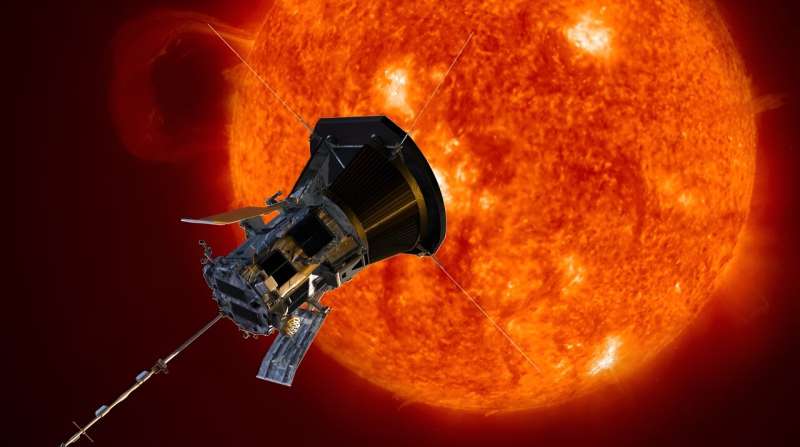The new study provides a simple and predictive theory for the formation of these magnetic reversals, involving work by researchers at the University of Michigan Department of Climate and Space Sciences and Engineering and Dr. Marco Velli, the lead scientist on the Parker Solar Probe mission.
What researchers discovered in the data sent back by the Parker Solar Probe after its flyby in 2018, was not what they expected.
"We expected the radial component of the magnetic field to be roughly constant and the oscillations to be perpendicular to that," said Toth. "But then, the Parker Solar Probe showed it is actually oscillating in the radial direction."
He wanted to find a way to explain how that was happening and the reason behind it. For the first time in years, Toth was inspired to return to theoretical work.
"You have an Alfvén wave, which is perpendicular to the magnetic field, and the idea is that it gets distorted and it starts to oscillate in different directions," said Toth. "This happens because the wave speeds are not constant. Originally, we thought it was the velocity of the plasma that mattered, but Bart pointed out this is, instead, due to the wave speed."
Working with his research team, he developed a qualitative and quantitative explanation of what is happening in the sun's inner heliosphere.
"First of all, the research is qualitative in that we describe this process with approximate formulas and simplified numerical simulations. After doing the modeling and theory, I spent a lot of time looking at the observations to check if they agree with what the theory predicts. The evidence is quite strong that this process is actually happening."
"We can actually measure the wave speed, and we do find that it varies. Where you see the switchback is the same place where you see the wave speed varying," said Toth.
"These waves originate near the sun's surface and become part of the solar wind. Initially, the magnetic field and the velocity have large fluctuations in the horizontal direction, but the waves get distorted by the varying wave speed, and eventually, the radial magnetic field flips over, forming a switchback."
New data available from the Parker Solar Probe made the research possible. The probe provided magnetic field measurements and plasma measurements at high resolution in never-before-seen proximity to the sun. Toth used observations of the density, velocity, temperature, and magnetic field to inform his research.
"That was very important because not only did we see that the magnetic field oscillates, but we also saw that the velocity of the plasma oscillates, and they oscillate together. So, they are proportionate to each other," said Toth. "If you only measure the magnetic field or you only measure the plasma, we couldn't establish this relationship."
The main goal of the Parker Solar Probe was to figure out how the solar wind is heated and accelerated, flying close enough to the sun to observe the phenomena.
"The Parker Solar Probe proved that what we believed was not quite right. Now, we have a better understanding about what was observed and how it formed," said Toth. "The next step is to see if this changes our theory of the solar wind. It could well change our models."
The main application of these models is to predict space weather, in order to better understand the heliosphere and to prepare for the powerful impacts space weather events can have on spacecraft, radio communication, GPS, and even the electric power grid. Already, researchers at the University of Michigan and beyond are collaborating on the Space Weather Modeling Framework, which aims to provide better forecasting for space weather events.
"This is an essential ingredient for future development of the space weather and solar wind models, and how the switchbacks can be included," said van der Holst. "You need, first, a mathematical framework and an understanding of the switchbacks before you can have a more complete picture of how to incorporate it in the solar wind model and explain the coronal heating mechanism."
One of the current models in the Space Weather Modeling Framework is the Alfvén Wave Solar-atmosphere Model (AWSoM), which aims to unravel the mysteries of Alfvén waves.
"In the modeling we have now, we assume essentially that Alfvén waves are responsible for coronal heating," said van der Holst. "This new theory fits nicely into that framework."
The new research provides a better understanding of how magnetic switchbacks are formed, which could lead to a deeper understanding of the turbulence in the solar wind, heating in the inner heliosphere, and, eventually, better space weather models.
"There are two main directions that we can take this work," said Toth. "We want to do the full three-dimensional numerical modeling of switchbacks, expanding the work to include turbulence. Then, we want to study how the formation of the switchbacks changes the theory of Alfvén wave heating."
More information: Gabor Toth et al. Theory of magnetic switchbacks fully supported by Parker Solar Probe observations, The Astrophysical Journal (2023). DOI: 10.3847/1538-4357/acfd91
Journal information:Astrophysical Journal
Provided by University of Michigan College of Engineering



